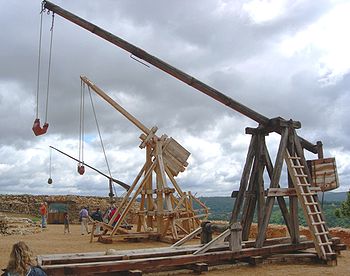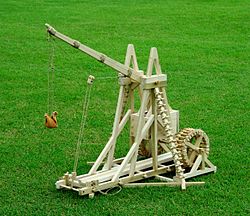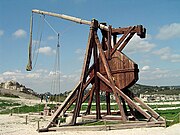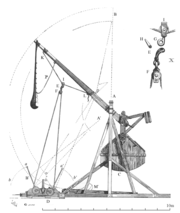
Trebuchets at Château de Castelnaud

Counterweight trebuchet constructed on the design of the "Warwolf"

Medieval traction trebuchet next to a staff slinger
A trebuchet[nb 1] (French trébuchet) is a siege engine used in the Middle Ages. It is sometimes called a counterweight trebuchet or counterpoise trebuchet, to distinguish it from an earlier weapon called the traction trebuchet, which employed pulling men working the mechanism.
The counterweight trebuchet appeared in both Christian and Muslim lands around the Mediterranean in the 12th century. It could fling projectiles weighing up to 350 pounds (160 kg) at or into enemy fortifications. Its use continued into the 15th century, well after the introduction of gunpowder.
The trebuchet's technical constructions were lost at the beginning of the 16th century. In 1984, the French engineer Renaud Beffeyte made the first modern reconstruction of a trebuchet, based on documents from 1324.[3]
Basic design[]
A trebuchet works by using the energy of a raised counterweight to throw a projectile. A long beam is attached to an axle. At the short end of the beam is attached the counter weight. The long end of the beam is pulled down, raising the counterweight. A sling, which has a pouch containing the projectile, is attached to the long end of the beam. Upon releasing the trigger, the sling and the beam swing upward, pivoting on the axle toward the vertical position, whereupon one end of the sling releases, opening the pouch and allowing the projectile to fly towards the target. The stored energy of the counterweight is transferred efficiently to the projectile.[4]
Modern-day enthusiasts have varied the original design, especially to control the path of the counterweight for increased efficiency.[5]
The three chief distinguishing characteristics of a trebuchet are:
- The machine is powered exclusively by gravity; most often directly by means of a counterweight, though sometimes indirectly (such as in a traction trebuchet).
- Such force rotates a throwing arm, usually four to six times the length of the counterweight arm, to multiply the speed of the arm and, eventually, the projectile.
- The machine utilizes a sling affixed to the end of the throwing arm, acting as a secondary fulcrum, to further multiply the speed of the projectile.
Trebuchet variations[]
The trebuchet is often confused with the earlier torsion siege engines. The main difference is that a torsion siege engine (examples of which include the onager and ballista) uses a twisted rope or twine to provide power, whereas a trebuchet uses a counterweight, placed much closer to the fulcrum than the projectile to provide (inverse) mechanical advantage and thereby sweep the long arm much faster than the counterweight falls. A trebuchet also has a sling holding the projectile (although the Roman onager often had a sling as well), and a means for releasing it at the right moment for maximum range. Further, the stroke finishes without the long arm slamming into a pad as with a torsion catapult producing the "kick" that prompted the name "onager". With a trebuchet, the action of the sling captures much of the forward speed of the arm just before release of the payload as could be seen in a strobe image.
The Couillard is a smaller version with a single stem or platform instead of the usual double "A" frames. The counterweight is split into two halves to avoid hitting the center stem.
History[]
Traction trebuchet[]

13th-century illustration for the Chronicle of John Skylitzes, depicting the Byzantines laying siege to a city.
The trebuchet derives from the ancient sling. A variation of the sling, called staff sling (Latin: fustibalus), contained a short piece of wood to extend the arm and provide greater leverage. This evolved into the traction trebuchet in which a number of people pulled on ropes attached to the short arm of a lever that has a sling on the long arm. This type of trebuchet is smaller and has a shorter range, but is a more portable machine and has a shorter cycle time than larger, counterweight-powered types. The smallest traction trebuchets could be powered by the weight and pulling strength of one person using a single rope, but most were designed and sized for between 15 and 45 men, generally two per rope. These teams would sometimes be local citizens helping in the siege or in the defense of their town. Traction trebuchets had a range of 100 to 200 feet (30 to 61 m) when casting weights up to 250 pounds (110 kg). It is believed that the first traction trebuchets were used by the Mohists in China as early as in the 5th century BC descriptions of which can be found in the Mojing (compiled in the 4th century BC). The Chinese named the later counterweight trebuchet Huihui Pao (Muslim Weapons, "huihui" means Muslim) or Xiangyang Pao (襄陽砲), where Pao means bombard.
The traction trebuchet next appeared in Byzantium. The Strategikon of Emperor Maurice, composed in the late 6th century, calls for "ballistae revolving in both directions," (Βαλλίστρας έκατηρωθεν στρεφόμενας), probably traction trebuchets (Dennis 1998, p. 99). The Miracles of St. Demetrius, composed by John I, archbishop of Thessalonike, clearly describe traction trebuchets in the Avaro-Slav artillery: "Hanging from the back sides of these pieces of timber were slings and from the front strong ropes, by which, pulling down and releasing the sling, they propel the stones up high and with a loud noise." (John I 597 1:154, ed. Lemerle 1979)
They were also used with great effect by the Islamic armies during the Muslim conquests. A surviving Arab technical treatise on these machines is Kitab Aniq fi al-Manajaniq ( "كتاب الأنيق في المنجنيق", An Elegant Book on Trebuchets), written in 1462 by Yusuf ibn Urunbugha al-Zaradkash. It provides detailed construction and operating information.
There is some doubt as to the exact period in which traction trebuchets, or knowledge of them, reached Scandinavia. The Vikings may have known of them at a very early stage, as the monk Abbo de St. Germain reports on the siege of Paris in his epic De bello Parisiaco dated about 890 AD that engines of war were used. Another source mentions that Nordic people or "the Norsemen" used engines of war at the siege of Angers as early as 873 AD[citation needed].
Hand-trebuchet[]
The hand-trebuchet (Greek: cheiromangana) was a staff sling mounted on a pole using a lever mechanism to propel projectiles. Basically a portable trebuchet which could be operated by a single man, it was used by emperor Nikephoros II Phokas around 965 to disrupt enemy formations in the open field. It was also mentioned in the Taktika of general Nikephoros Ouranos (c. 1000), and listed in De obsidione toleranda (author anonymous) as a form of artillery.[6]
Counterweight trebuchet[]

Counterweight trebuchet at Château des Baux, France

Counterweight trebuchet by the German engineer Konrad Kyeser (c. 1405)

19th century French three-quarter drawing of a medieval counterweight trebuchet

Side view of counterweight trebuchet
The earliest written record of the counterweight trebuchet, much more powerful than the traction version, appears in the work of the 12th century Byzantine historian Niketas Choniates. Niketas describes a trebuchet used by Andronikos I Komnenos, future Byzantine emperor, at the siege of Zevgminon in 1165 which was equipped with a windlass, an apparatus which was required neither for traction nor hybrid trebuchets to launch missiles.[7] Chevedden dates the invention of the new artillery type back to the Siege of Nicaea in 1097 when the Byzantine emperor Alexios I Komnenos, an ally of the besieging crusaders, was reported to have invented new pieces of heavy artillery which deviated from the conventional design and made a deep impression on everyone.[8]
The dramatic increase in military performance is for the first time reflected in historical records on the occasion of the second siege of Tyre in 1124, when the crusaders reportedly made use of "great trebuchets".[9] By the 1120–30s, the counterweight trebuchet had diffused not only to the crusaders states, but probably also westwards to the Normans of Sicily and eastwards to the Great Seljuqs. The military use of the new gravity-powered artillery culminated in the 12th century during the Siege of Acre (1189–91) which saw the kings Richard I of England and Philip II of France wrestle for control of the city with Saladin's forces.[10]
The only pictorial evidence of a counterweight trebuchet in the 12th century comes from an Islamic scholar, Mardi bin Ali al-Tarsusi, who wrote a military manual for Saladin circa 1187.[10][11] He describes a hybrid trebuchet that he said had the same hurling power as a traction machine pulled by fifty men due to "the constant force [of gravity], whereas men differ in their pulling force." (Showing his mechanical proficiency, Tarsusi designed his trebuchet so that as it swung it cocked a supplementary crossbow, probably to protect the engineers from attack.)[12]
During the Crusades, Philip II of France named two of the trebuchets he used in the Siege of Acre in 1191 "God's Stone-Thrower" and "Bad Neighbor."[13] During a siege of Stirling Castle in 1304, Edward Longshanks ordered his engineers to make a giant trebuchet for the English army, named "Warwolf". Range and size of the weapons varied. In 1421 the future Charles VII of France commissioned a trebuchet (coyllar) that could shoot a stone of 800 kg, while in 1188 at Ashyun, rocks up to 1,500 kg were used. Average mass of the projectiles was probably around 50–100 kg, with a range of ca. 300 meters. The cycle rate could be noteworthy: at the siege of Lisbon (1147), two engines were capable of launching a stone every 15 seconds. Also human corpses could be used on special occasion: in 1422 Prince Korybut, for example, in the siege of Karlštejn Castle shot men and manure within the enemy walls, apparently managing to spread infection among the defenders. The largest trebuchets needed exceptional quantities of timber: at the Siege of Damietta, in 1249, Louis IX of France was able to build a stockade for the whole Crusade camp with the wood from 24 captured Egyptian trebuchets.
Counterweight trebuchets do not appear with certainty in Chinese historical records until about 1268, when the Mongols laid siege to Fancheng and Xiangyang. At the Siege of Fancheng and Xiangyang, the Mongol army, unable to capture the cities despite besieging the Song defenders for years, brought in two Persian engineers who built hinged counterweight trebuchets and soon reduced the cities to rubble, forcing the surrender of the garrison. These engines were called by the Chinese historians the Huihui Pao (回回砲)("huihui" means Muslim) or Xiangyang Pao (襄陽砲), because they were first encountered in that battle. Recent research by Paul E. Chevedden indicates that the hui-hui pao was actually a European design, a double-counterweight engine that had been introduced to the Levant by Holy Roman Emperor Frederick II (1210–1250) only shortly before.[14] The Muslim historian Rashid-al-Din Hamadani (1247?–1318) refers in his Universal History to the Mongol trebuchets used at the Song cities as "Frankish" or "European trebuchets" ("manjaniq ifranji" or "manjaniq firanji"):
Before that there had not been any large Frankish catapult in Cathay [i.e. China], but Talib, a catapult-maker from this land, had gone to Baalbek and Damascus, and his sons Abubakr, Ibrahim, and Muhammad, and his employees made seven large catapults and set out to conquer the city [Sayan Fu or Hsiang-yang fu = modern Xiangfan].[15]
With the introduction of gunpowder, the trebuchet lost its place as the siege engine of choice to the cannon. Trebuchets were used both at the siege of Burgos (1475–1476) and siege of Rhodes (1480). One of the last recorded military uses was by Hernán Cortés, at the 1521 siege of the Aztec capital Tenochtitlán. Accounts of the attack note that its use was motivated by the limited supply of gunpowder. The attempt was reportedly unsuccessful: the first projectile landed on the trebuchet itself, destroying it.[16]
In 1779, British forces defending Gibraltar, finding that their cannons were unable to fire far enough for some purposes, constructed a trebuchet. It is unknown how successful this was: the Spanish attackers were eventually defeated, but this was largely due to a sortie.[citation needed]
In 2013, during the Syrian civil war, rebels were filmed using a trebuchet in the Battle of Aleppo.[17] The trebuchet was used to lob explosives at government troops.
Modern recreational use[]

Trebuchet at Middelaldercentret, Denmark.
Trebuchets are highly popular in modern times in a number of contexts. In particular, traditional models are constructed by historical re-enactment and living history enthusiasts, and others use the trebuchet as an engineering challenge,[18][19] or for recreational purposes.
The largest currently-functioning trebuchet in the world is the 22-tonne machine at Warwick Castle, England. Based on historical designs, it stands 18 metres tall (59 ft) and throws missiles typically 36 kg (80 lbs) up to 300 metres (984 ft). It is built on the design of a similar trebuchet at Middelaldercentret in Denmark.[20] Middelaldercentret was the first place in modern times a working trebuchet was constructed which happened in 1989.[20]
Trebuchets are used to throw pumpkins at the annual pumpkin chunking contest held in Sussex County, Delaware, USA. The record-holder in that contest for trebuchets is the Yankee Siege II, which at the 2011 WCPC Championship tossed a pumpkin 2326.6 ft (709.1 metres). The 51-foot-tall (16 m), 55,000-pound (25,000 kg) trebuchet flings the standard 8–10-pound (3.6–4.5 kg) pumpkins,[21] specified for all entries in the WCPC competition.
Modern engineering thought and materials have come up with several non-traditional designs, in particular, several with "floating arms" to increase efficiency. A floating-arm trebuchet is an efficient modern variant. Rather than having an axle fixed to the frame, it is mounted on wheels that roll on a track parallel to the ground, and the counterweight is constrained to fall in a direct path downwards upon the release. This increases the proportion of energy transferred to the projectile.[5]
Even more radical designs exist which the ancients arguably would not even recognize as trebuchets. For example, "Merlin"[22] uses no counterweight whatsoever—the weight of the machine itself is what powers this trebuchet.
See also[]
Notes[]
- ↑ OED, Random House Unabridged Dictionary
- ↑ Random House Unabridged Dictionary
- ↑ http://armedieval.fr
- ↑ Siano, pp 5,6 and 37
- ↑ 5.0 5.1 RLT Industries. "The Original Floating Arm Trebuchet". Trebuchet.com. New Braunfels, TX. http://www.trebuchet.com/firstfat. Retrieved May 3, 2010.
- ↑ Chevedden 2000, p. 110
- ↑ Chevedden 2000, p. 86
- ↑ Chevedden 2000, pp. 76–86; 110f.
- ↑ Chevedden 2000, p. 92
- ↑ 10.0 10.1 Chevedden 2000, pp. 104f.
- ↑ Bradbury, Jim (1992). The Medieval Siege. The Boydell Press. ISBN 0-85115-312-7.
- ↑ "Historynet.com". Historynet.com. http://www.historynet.com/wars_conflicts/weaponry/3823351.html?page=2&c=y. Retrieved 2010-09-12.
- ↑ "Historic Trebuchets – Acre 1191", IInet.net.au
- ↑ "Black Camels and Blazing Bolts: The Bolt-Projecting Trebuchet in the Mamluk Army", Mamluk Studies Review Vol. 8/1, 2004, pp. 227–277 (232f.)
- ↑ Rashiduddin Fazlullah’s Jamiʻuʾt-tawarikh (Compendium of Chronicles), English translation & annotation by W.M. Thackston, 3 vols., Cambridge, Mass.: Harvard University, Dept. of Near Eastern Languages and Civilizations, 1998–99, 2: 450
- ↑ Chevedden 1995, p. 5
- ↑ http://www.youtube.com/watch?v=LmKCWjh-FZM
- ↑ "Thelep.org.uk". Thelep.org.uk. 2008-11-20. http://www.thelep.org.uk/teachers/events/view/54. Retrieved 2010-09-12.
- ↑ "Wright.edu". Engineering.wright.edu. http://www.engineering.wright.edu/trebuchet/. Retrieved 2010-09-12.
- ↑ 20.0 20.1 June 14, 2005 Reconstructing Medieval Artillery. archive.archaeology.org. Retrieved 12 September 2013
- ↑ "World Championship Punkin Chunkin-Current World Records". punkinchunkin.com. http://punkinchunkin.com/current-world-record. Retrieved November 20, 2012.
- ↑ Merlin Trebuchet Website
Bibliography[]
- Chevedden, Paul E.; et al. (July 1995). "The Trebuchet". pp. 66–71. Archived from the original on 2004-07-26. http://web.archive.org/web/20040726001919/http://www.deremilitari.org/resources/pdfs/trebuchet.pdf.. Original version.
- Chevedden, Paul E. (2000). "The Invention of the Counterweight Trebuchet: A Study in Cultural Diffusion". pp. 71–116. Digital object identifier:10.2307/1291833. JSTOR 1291833.
- Dennis, George (1998). "Byzantine Heavy Artillery: The Helepolis".
- Gravett, Christopher (1990). Medieval Siege Warfare. Osprey Publishing.
- Hansen, Peter Vemming (April 1992). "Medieval Siege Engines Reconstructed: The Witch with Ropes for Hair". pp. 15–20.
- Hansen, Peter Vemming (1992). "Experimental Reconstruction of the Medieval Trebuchet". pp. 189–208. http://www.middelaldercentret.dk/acta.html.
- Jahsman, William E.; MTA Associates (2000). The Counterweighted Trebuchet – an Excellent Example of Applied Retromechanics. http://www.thehurl.org/tiki-download_file.php?fileId=9.
- Jahsman, William E.; MTA Associates (2001). FATAnalysis. http://www.ripcord.ws/FATAnalysis.PDF.
- Archbishop of Thessalonike, John I (1979). Miracula S. Demetrii, ed. P. Lemerle, Les plus anciens recueils des miracles de saint Demitrius et la penetration des slaves dans les Balkans. Centre National de la Recherche Scientifique.
- Liang, Jieming (2006). Chinese Siege Warfare: Mechanical Artillery & Siege Weapons of Antiquity – An Illustrated History.
- Needham, Joseph (2004). Science and Civilization in China. Cambridge University Press. p. 218.
- Needham, Joseph (1986). Science and Civilization in China: Volume 4, Part 2. Taipei: Caves Books, Ltd.
- Payne-Gallwey, Sir Ralph (1903 Reprinted). "LVIII The Trebuchet". The Crossbow With a Treatise on the Balista and Catapult of the Ancients and an Appendix on the Catapult, Balista and Turkish Bow. pp. 308–315.
- Saimre, Tanel (2007). Trebuchet – a gravity operated siege engine. A Study in Experimental Archaeology. http://www.kirj.ee/public/va-arh/arch-2006-1-3.pdf.
- Siano, Donald B. (March 28, 2001). Trebuchet Mechanics. Archived from the original on May 25, 2004. http://web.archive.org/web/20040525103721/http://www.algobeautytreb.com/trebmath35.pdf.
- Al-Tarsusi (1947). Instruction of the masters on the means of deliverance from disasters in wars. Bodleian MS Hunt. 264. ed. Cahen, Claude, "Un traite d'armurerie compose pour Saladin". Bulletin d'etudes orientales 12 [1947–1948]:103–163.
External links[]
| Wikimedia Commons has media related to Trebuchet. |
| Look up trebuchet in Wiktionary, the free dictionary. |
| Wikisource has the text of the 1911 Encyclopædia Britannica article Trébuchet. |
- Trebuchet Build Plans
- Secrets of Lost Empires: Medieval Siege (building of and history of trebuchets), from the NOVA website
- Warwick trebuchet
- Video Demonstration of the Medieval Siege Society's trebuchet
- Caerphilly Castle trebuchet shooting
- Trebuchet animation
- Virtual Trebuchet
- Trebuchet de l'AMQ a St-Marcellin on YouTube
- Slow motion mini trebuchet on YouTube
- Floating arm trebuchet on YouTube
- Traction Trebuchet hurling a football on YouTube
| ||||||||||
The original article can be found at Trebuchet and the edit history here.
